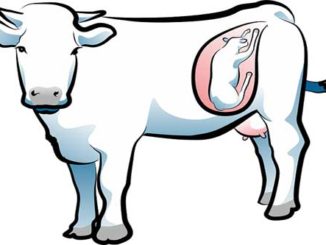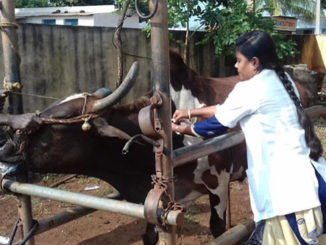While visiting dairy farms in Punjab, we noticed on many occasions the unnatural behaviour of cows eating soil. According to the concerned farmers, cattle usually eat soil when they are transferred from one compartment to the other or when they are brought to the milking parlour. The cattle often eat soil repeatedly from a very particular point on their way. This frequently led to development of small pits in the sandy floor. Whenever, trolley-load of new sand is brought to the premises for leveling the floor, the cows roaming in the paddock scoot in groups to gulp that sand as if they are hungry for days together.
This behaviour of soil eating is more commonly observed in adult animals as compared to heifers. Lactation plays an important role in the development of this behaviour. Animals in late lactation are more likely to exhibit this abnormal behaviour probably due to prolonged drainage of body reserves. Seasons are also known to modify this type of behaviour. More number of animals starts showing this habit in winter months. Time of the day too plays its role in the exhibition of this unnatural behaviour. Majority of the animals prefer to taste the soil during noon.
There are many theories available to explain the origin of this unnatural behaviour. Deficiency of common salt in the diet of cows is considered one of the likely causes of soil eating. Cattle fulfill their needs of salt by consuming soil or sand. Animal nutritionists, often, recommend addition of common salt to the concentrate ration at the rate of one per cent. In addition to this, sufficient number of rock salt blocks should also be placed in the manger. Cows with greater demands can fulfill their needs by licking those pieces. The blocks of rock salt can also be chiselled into the shape of wheels which are made to rotate on some kind of axle e.g. wooden rod. These wooden rods are fixed above mangers, thereby, allowing animals to lick salt whenever they like to.
The high yielding cattle have greater requirements of dry matter. To increase the dry matter intake, large quantities of concentrate ration is, often, fed to them. This leads to production of huge quantities of volatile fatty acids which cause lowering of pH of rumenal contents. To counteract this increased acidity, the cattle start eating soil. Most of the soils in Punjab are alkaline in nature with pH ranging between 7.8 and 8.5. These soils when eaten appear to improve the pH of rumen, thereby, sustaining the health of the animal. Under such scenarios, soil eating cattle should be provided higher quantities of green fodder that too of very high quality. Some dry fodder like wheat straw may also be included in the diet. This will increase the rumination time leading to higher production of saliva. Since saliva contains sodium bicarbonate, it will help in neutralizing excessive acids in the rumen. To improve salivation, we can also tie a cotton rope above polls after passing it through the mouth just like halter of a horse.
Many commercial farmers provide anionic feeds to animals just before calving. Such feeds are also responsible for lowering of rumenal pH. Animals try to extenuate the situation by eating dirt. Therefore, it is better to avoid unnecessary changes in animal feeds. The estimation of urine pH at weekly intervals prior to calving can determine if the feeds are balanced. Under normal circumstances, the urine pH of cattle should be alkaline, just above 8.0. The urine pH turns acidic but still remains above 6.0 when optimum quantity of anionic feed is fed. In no case, it should be below 6.0. It will, then, indicate excessive feeding of anionic feeds.
There is another viewpoint to explain the consumption of soils by cattle. When cattle consume concentrate ration infested with various kinds of fungi, they usually start eating soil just to counteract bad effects of mycotoxins. The soil particles, in fact, try to adsorb molecules of various mycotoxins in the alimentary tract of the animal, thereby, palliating the bad effects of those mycotoxins to some extent.
The mycotoxins accumulate in the ration when moisture level exceeds a permissible limit (usually 10% level). This may happen when molasses are added to the ration. The individual ingredients may also contain higher amounts of moisture. Storage of ration bags at damp places can also lead to fungal attacks. The farms which use brewery waste for their animals need to utilize each installment within three days. The lot may get infested with moulds thereafter, especially during summer months. Where the brewery waste is allowed to be fed to cows in mangers, the leftovers need to be removed daily. The mangers especially their corners should be cleaned thoroughly with the help of a brush with very strong bristles. An old hard broom can also do the job. In absence of such maneuvers, the leftovers can get piled up in corners of mangers leading to easy fungal attacks.
Majority of cattle farmers in Punjab these days are dependent on silage. Silage making is an art. The silo pit should be filled in such a way that there are no air pockets left in between different layers of the pressed fodder. There should never be seepage of any water into these pits. Presence of air pockets and excessive moisture within silo-pits often lead to its spoilage through fungal attacks. Feeding of spoiled silage usually causes increased consumption of soil.
Elimination of fungal toxins in the diet of animals by any means is one of the best methods of mitigating unnatural behaviour of soil eating in cattle.
Eating small amounts of soil and that too occasionally, pose no threat to the health of the animal. However, large amounts of dirt or soil can lead to rumenal tympany, abomasal impaction, weight loss or severe constipation. Signs of pain are evident from a long distance. The affected animal is, often, seen kicking her lower belly. Large amount of sand in absence of intake of normal water can cement the intestinal contents leading to complete blockage and rupture of intestines. Soils, often, contain eggs or cysts of various helminths. There is greater probability of worm infestation in animals who venture into soil eating. Soil eating animals usually excrete acidic urine where pH is often below 6.0.
The farmers are, thus, advised to look into possible causes of this unnatural behavior of their animals. Elimination of those causes will automatically keep the animals going strong.







Be the first to comment